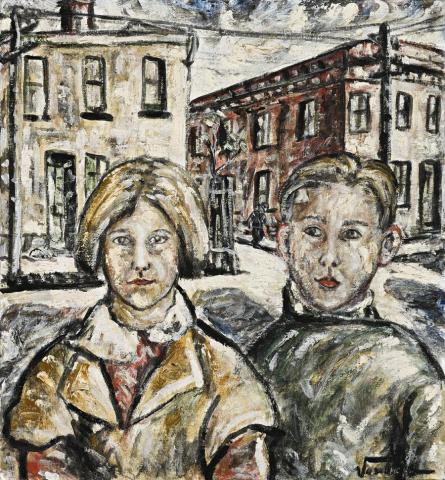FITZROY CHILDREN, 1937
DANILA VASSILIEFF
oil on canvas
56.0 x 51.5 cm
signed lower right: Vassilieff
Collection of Lina Bryans, Melbourne
Thence by descent
Private collection, Melbourne
Landfall, National Gallery of Victoria, Melbourne, 6 April - 30 June 1970 (label attached verso)
Galbally, A., Landfall: The Captain James Cook Bicentenary Exhibition of Australian Art, National Gallery of Victoria, Melbourne, 1970, cat. 1937b (unpaginated)
Here the two children in the lower half, probably a brother and a sister, look away from the faded grandeur of their background - the inner suburb of Fitzroy - towards and past the artist. They capture the eternal in the everyday. They are what Danila Vassilieff would have described as the 'real' people, those who would not normally be painted.
Danila Vassilieff had assimilated the Russian expressionist aesthetic in London: the notion of the artist transcending the commonplace through the intensity of his own expression. The quickness of his brushmarks and bold strokes of raw pigment express the immediacy of his vision, his non-academic direct response to his subject. And his full personal involvement continues into the original hand-made frame, with its combed plaster finish.
An almost classic Fitzroy street scene, this painting reflects the humanism Vassilieff brought to Australian art. The two adolescents anchor the composition, rapidly brushed, in mainly earth colours. Their black rounded outlines contrast with the structural lines of their setting, for example the telegraph pole that springs up from his head and the honey-comb of black guttering that links her bundle of hair to the corral around the wintry street tree.
In similar fashion, the flurry of warm reds and yellows of her pullover and jacket refer back to the peeling facades, keying through the rosebud lips of her brother; while his green-tinged jacket connects through their cast shadows on the road with the doorway behind her centrally-parted hair.
Vassilieff loved children. A Don Cossack, he came from a large family in the south of Russia from whom he had been separated since the Revolution. Here, in the streets of Fitzroy, he was close to his subject matter. As his wife told a reporter: 'He does not need to go searching for subjects ... he often has a chat with the children of the neighbourhood and paints them too ... the children flock around her husband, he has many friends too with the dogs of the neighbourhood who are always apt to get painted into the street scene.'
The speed at which Vassilieff worked caught not only his response to them but also theirs to him: her calm, confident and trusting gaze and his more cautious expression as he looks with pursed lips into the future.
Lina Bryans, the young artist who also painted with Vassilieff, bought this painting at one of his first two exhibitions at Riddell's Galleries, regarding it as his best. She commented on the deliberation of his brushmarks, both within and outside the faces.
FELICITY ST JOHN MOORE
